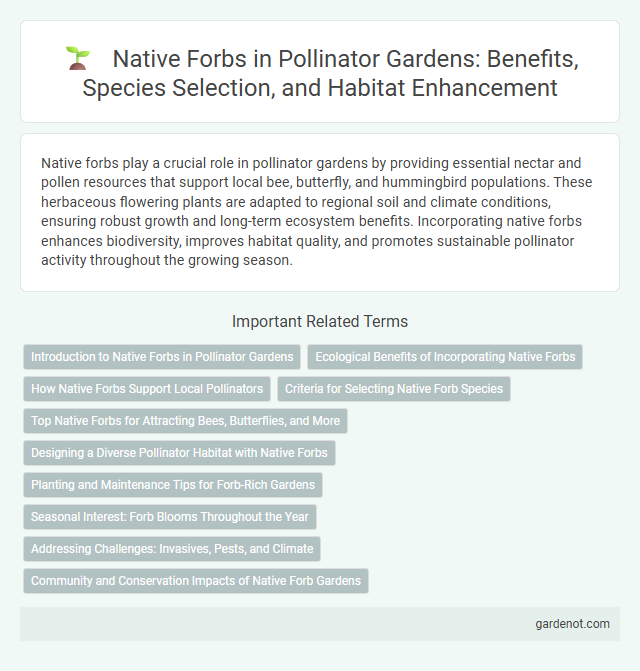Native forbs play a crucial role in pollinator gardens by providing essential nectar and pollen resources that support local bee, butterfly, and hummingbird populations. These herbaceous flowering plants are adapted to regional soil and climate conditions, ensuring robust growth and long-term ecosystem benefits. Incorporating native forbs enhances biodiversity, improves habitat quality, and promotes sustainable pollinator activity throughout the growing season.
Introduction to Native Forbs in Pollinator Gardens
Native forbs are herbaceous flowering plants essential to pollinator gardens, providing vital nectar and pollen resources for bees, butterflies, and other pollinators. These species, adapted to local climates and soil conditions, support biodiversity by sustaining native pollinator populations and enhancing ecosystem resilience. Incorporating a diverse mix of native forbs, such as milkweed, coneflower, and black-eyed Susan, optimizes habitat quality and promotes healthy pollination processes.
Ecological Benefits of Incorporating Native Forbs
Native forbs enhance pollinator gardens by providing essential nectar and pollen sources for bees, butterflies, and other pollinators. Their deep root systems improve soil health, prevent erosion, and increase water infiltration, supporting ecosystem resilience. Incorporating native forbs fosters biodiversity, promotes wildlife habitat, and sustains local ecological balance.
How Native Forbs Support Local Pollinators
Native forbs play a crucial role in sustaining local pollinators by providing essential nectar and pollen resources throughout the growing season. Their specialized relationships with native bees, butterflies, and other pollinators enhance biodiversity and promote ecosystem resilience. Incorporating native forb species into pollinator gardens fosters habitat connectivity and supports the life cycles of indigenous pollinator populations.
Criteria for Selecting Native Forb Species
Selecting native forb species for a pollinator garden involves prioritizing plants that provide abundant nectar and pollen resources to support a diverse range of pollinators. Species should be well-adapted to local soil and climate conditions, ensuring sustainable growth and minimal maintenance. Choosing forbs with staggered bloom times maximizes seasonal food availability, enhancing habitat resilience and ecosystem health.
Top Native Forbs for Attracting Bees, Butterflies, and More
Top native forbs such as Echinacea purpurea (purple coneflower), Asclepias tuberosa (butterfly weed), and Solidago spp. (goldenrod) provide vital nectar and pollen resources for pollinators including bees, butterflies, and hummingbirds. These species support local ecosystems by sustaining diverse pollinator populations, improving pollination efficiency for native plants. Planting a variety of native forbs ensures extended bloom periods, maximizing habitat value and pollinator attraction throughout the growing season.
Designing a Diverse Pollinator Habitat with Native Forbs
Integrating native forbs such as Echinacea, Solidago, and Asclepias into pollinator garden designs enhances floral diversity and provides essential nectar and pollen resources for bees, butterflies, and hummingbirds. These native forbs support local pollinator species by blooming sequentially throughout the growing season, ensuring continuous food availability and promoting ecosystem resilience. Selecting a variety of native forb species adapted to regional soil and climate conditions maximizes habitat suitability and pollinator attraction.
Planting and Maintenance Tips for Forb-Rich Gardens
Plant native forbs in well-drained soil with full sun exposure to encourage robust growth and vibrant blooms, essential for supporting diverse pollinator species. Regularly remove invasive weeds and deadhead spent flowers to promote continuous blooming and prevent competition for nutrients. Incorporate seasonal mulching and avoid excessive watering to maintain soil health and reduce fungal diseases in forb-rich pollinator gardens.
Seasonal Interest: Forb Blooms Throughout the Year
Native forbs provide essential seasonal interest in a pollinator garden with blooms that attract diverse pollinators throughout the year. Species such as Echinacea, Black-eyed Susan, and Butterfly weed offer staggered flowering from spring to fall, supporting bees, butterflies, and other pollinators across seasons. Incorporating a variety of native forbs ensures continuous nectar sources, promoting ecological balance and enhancing pollinator habitat year-round.
Addressing Challenges: Invasives, Pests, and Climate
Native forbs play a crucial role in pollinator gardens by enhancing biodiversity and supporting local ecosystems against invasive species that threaten native plant populations. Their deep-root systems improve soil health, making these gardens more resilient to pests and climate variability, including drought and temperature extremes. Incorporating a diverse mix of native forbs helps maintain habitat stability and promotes the long-term survival of pollinator species.
Community and Conservation Impacts of Native Forb Gardens
Native forb gardens play a crucial role in supporting pollinator populations by providing diverse, region-specific nectar and pollen sources essential for native bees, butterflies, and other insects. These gardens enhance local biodiversity, promote habitat connectivity, and contribute to ecosystem resilience by sustaining wildlife and improving soil health. Community-driven native forb garden projects foster environmental stewardship, raise awareness about conservation needs, and create green spaces that support sustainable urban and rural landscapes.
Native forb Infographic

 gardenot.com
gardenot.com